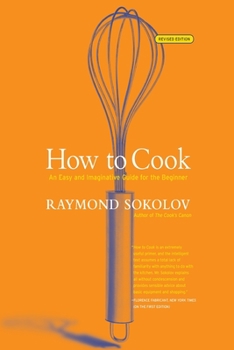How to Cook Revised Edition: An Easy and Imaginative Guide for the Beginner
Select Format
Select Condition 
Book Overview
A fully revised and updated edition of Raymond Sokolov's classic kitchen primer for beginning chefs of all ages, filled with 150 simple, sophisticated recipes, easy-to-learn techniques, and indispensable advice. First published in 1986, Ray Sokolov's How To Cook is the ultimate book for beginning cooks of all ages. Unlike most kitchen primers, How To Cook does not assume any prior cooking instruction or skills, but rather guides the reader through the entire cooking process with simple explanations in ordinary language. There are no fancy cooking terms or special gadget here, just easy, indispensable techniques and foolproof recipes for every occasion. In this revised paperback edition, Sokolov addresses the increased sophistication of even adamant non-cooks in today's food-obsessed climate, while he sticks to the unfussy, straightforward approach that made the original such a hit. Home cooks will learn everything they need for years worth of fabulous meals, from how to decipher recipe measurements, to how to fry an egg, to how to steam a lobster. Even readers weaned on frozen pizza will find recipes they can master, for last minute meals, special occasions and entertaining, and even holidays-all made from scratch with fresh, accessible ingredients. Experienced cooks will appreciate the simple elegance of such flavorful dishes as Veal Scallopini or Pears Poached in Red Wine. Written with Sokolov's trademark wit and wisdom, How To Cook is an invaluable kitchen classic you'll turn to again and again.
Format:Paperback
Language:English
ISBN:0060083913
ISBN13:9780060083915
Release Date:May 2004
Publisher:William Morrow & Company
Length:320 Pages
Weight:0.25 lbs.
Dimensions:0.9" x 6.4" x 9.2"
Customer Reviews
2 ratings
one of my favorite cook books
Published by Thriftbooks.com User , 16 years ago
I've been reading Sokolov's columns in the Wall Street Journal and I finally bought this book. It would make a good gift for a beginning cook. Also his "The Jewish American Kitchen" is very interesting.
Great Culinary Advice, Quirky Organization, Great Read
Published by Thriftbooks.com User , 20 years ago
Raymond Sokolov's simply entitled book `How To Cook' attempts to answer to the needs of all the culinarily clueless men and women he addresses in his introduction. The simple, elegant cover design, small size, and inviting subtitle `An Easy and Imaginative Guide for the Beginner' promises us a culinary Strunk and White's `The Elements of Style'. Like the famous writers of this manual on English usage, the author also has serious credentials as a writer for famous journals. There is one very significant problem with this analogy.In simplest terms, writing style and usage, like logic, can have rules that are always true. Cooking, like biology, always seems to want to color outside the lines. To take a very simple example, every written description and every TV demonstration of omelet making does things just a little different. The variations are so rampant that the great culinary writer Elizabeth David said that the right way to make an omelet is the way you want to make it. Of course, she proceeds to give you a long procedure on how to make a proper French omelet. Sokolov gives no clue to this point of view when he presents the method for making an omelet. In fact, he seems to leave out at least half of the steps many people consider essential. I truly fear that someone approaching omelet making for the first time with Sokolov's instructions will have several failures before achieving omelet perfection. And, since omelet making is all about technique, why are there no pictures? The same question applies to every other classic culinary skill Sokolov describes such as making a piecrust and breading a veal scallopine. One can argue that pictures would steal space from Sokolov's enjoyable and highly opinionated prose. And, I will agree with that argument, as long as I can treat this book more like a culinary essay by Elizabeth David than like a text by Jaques Pepin or Madeline Kamman.Sokolov opens his book with a truly excellent guide to the modern kitchen. The discussion on how to read a recipe is the best I have seen. One is reminded of Mortimer Adler's classic `How to Read a Book'. His precis on the oven, the range, and the refrigerator are priceless and should be reprinted in every book of culinary writing from now to kingdom come, with one small exception. In recommending a range configuration, Sokolov suggests you get one where the four burners are close together to enable a large stockpot to be heated by all four simultaneously. This suggestion fails for the simple reason that the average single or small family cook will rarely make stock in anything larger than a 12 quart stock pot. I make stock fairly regularly, and I find it is much more common for me to need two large diameter burners far apart to accommodate an 8 quart pasta pot and an 8 quart enameled casserole than I need a configuration to support a 20 quart stock pot. I do not wish to make too much of this or any other difference. My point is not that Sokolov is wrong, my point is that





